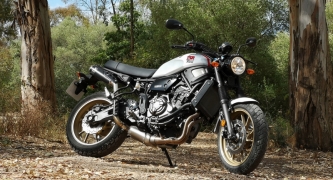 Yamaha XSR700 - Owner's Manual > Checking the spark plugs
Yamaha XSR700 - Owner's Manual > Checking the spark plugs
The spark plugs are important engine components, which should be checked periodically, preferably by a Yamaha dealer. Since heat and deposits will cause any spark plug to slowly erode, they should be removed and checked in accordance with the periodic maintenance and lubrication chart. In addition, the condition of the spark plugs can reveal the condition of the engine.
The porcelain insulator around the center electrode of each spark plug should be a medium-to-light tan (the ideal color when the vehicle is ridden normally), and all spark plugs installed in the engine should have the same color. If any spark plug shows a distinctly different color, the engine could be operating improperly. Do not attempt to diagnose such problems yourself. Instead, have a Yamaha dealer check the vehicle.
If a spark plug shows signs of electrode
erosion and excessive carbon or
other deposits, it should be replaced.

Before installing a spark plug, the spark plug gap should be measured with a wire thickness gauge and, if necessary, adjusted to specification.

- Spark plug gap
 Clean the surface of the spark
plug
gasket and its mating surface, and
then wipe off any grime from the spark
plug threads.
Clean the surface of the spark
plug
gasket and its mating surface, and
then wipe off any grime from the spark
plug threads. 
TIP
If a torque wrench is not available when installing a spark plug, a good estimate of the correct torque is 1/4- 1/2 turn past finger tight. However, the spark plug should be tightened to the specified torque as soon as possible.
NOTICE
Do not use any tools to remove or install the spark plug cap, otherwise the ignition coil coupler may get damaged. The spark plug cap may be difficult to remove because the rubber seal on the end of the cap fits tightly. To remove the spark plug cap, simply twist it back and forth while pulling it out; to install it, twist it back and forth while pushing it in.
Canister

This model is equipped with a canister to prevent the discharging of fuel vapor into the atmosphere. Before operating this vehicle, make sure to check the following:
- Check each hose connection.
- Check each hose and canister for cracks or damage. Replace if damaged.
- Make sure that the canister breather is not blocked, and if necessary, clean it.
Engine oil and oil filter cartridge
The engine oil level should be checked before each ride. In addition, the oil must be changed and the oil filter cartridge replaced at the intervals specified in the periodic maintenance and lubrication chart.
To check the engine oil level
1. Place the vehicle on a level surface and hold it in an upright position.
A slight tilt to the side can result in a false reading.
2. Start the engine, warm it up for several minutes, and then turn it off.
3. Wait a few minutes for the oil level to settle for an accurate reading, and then check the oil level through the engine oil level check window located at the bottom-left side of the crankcase.
TIP
The engine oil should be between the minimum and maximum level marks.

- Engine oil filler cap
- Engine oil level check window
- Maximum level mark
- Minimum level mark
4. If the engine oil is below the minimum level mark, add sufficient oil of the recommended type to raise it to the correct level.
TIP
Check the O-ring for damage, and replace it if necessary.

- Engine oil filler cap
- O-ring
To change the engine oil (with or without oil filter cartridge replacement)
1. Place the vehicle on a level surface.
2. Start the engine, warm it up for several minutes, and then turn it off.
3. Place an oil pan under the engine to collect the used oil.
4. Remove the engine oil filler cap, the engine oil drain bolt and its gasket to drain the oil from the crankcase.

- Engine oil drain bolt
- Gasket
TIP
Skip steps 5-7 if the oil filter cartridge is not being replaced.
5. Remove the oil filter cartridge with an oil filter wrench.

- Oil filter wrench
- Oil filter cartridge
TIP
An oil filter wrench is available at a Yamaha dealer.
6. Apply a thin coat of clean engine oil to the O-ring of the new oil filter cartridge.

- O-ring
TIP
Make sure that the O-ring is properly seated.
7. Install the new oil filter cartridge with an oil filter wrench, and then tighten it to the specified torque with a torque wrench.

- Torque wrench
Tightening torque:
Oil filter cartridge: 17 N*m (1.7 kgf*m, 13 lb*ft)
8. Install the engine oil drain bolt and its new gasket, and then tighten the bolt to the specified torque.
Tightening torque:
Engine oil drain bolt: 43 N*m (4.3 kgf*m, 32 lb*ft)
9. Refill with the specified amount of the recommended engine oil.
Recommended engine oil
Oil quantity:
Oil change: 2.30 L (2.43 US qt, 2.02 Imp.qt)
With oil filter removal: 2.60 L (2.75 US qt, 2.29 Imp.qt)
TIP
Be sure to wipe off spilled oil on any parts after the engine and exhaust system have cooled down.
NOTICE
- In order to prevent clutch slippage (since the engine oil also lubricates the clutch), do not mix any chemical additives. Do not use oils with a diesel specification of "CD" or oils of a higher quality than specified. In addition, do not use oils labeled "ENERGY CONSERVING II" or higher.
- Make sure that no foreign material enters the crankcase.
10. Check the O-ring for damage, and replace it if necessary.

- Engine oil filler cap
- O-ring
11. Install and tighten the engine oil filler cap.
12. Start the engine, and then let it idle for several minutes while checking it for oil leakage. If oil is leaking, immediately turn the engine off and check for the cause.
TIP
After the engine is started, the engine oil pressure warning light should go off.
NOTICE
If the oil pressure warning light flickers or remains on even if the oil level is correct, immediately turn the engine off and have a Yamaha dealer check the vehicle.
13. Turn the engine off, wait a few minutes for the oil level to settle for an accurate reading, and then check the oil level and correct it if necessary.
Why Yamalube
YAMALUBE oil is a Genuine YAMAHA
Part born of the engineers' passion
and belief that engine oil is an important
liquid engine component. We form
teams of specialists in the fields of mechanical
engineering, chemistry, electronics
and track testing, and have
them develop the engine together with
the oil it will use. Yamalube oils take full
advantage of the base oil's qualities
and blend in the ideal balance of additives
to make sure the final oil clears
our performance standards. Thus,
Yamalube mineral, semisynthetic and
synthetic oils have their own distinct
characters and value. Yamaha's experience
gained over many years of research
and development into oil since
the 1960's helps make Yamalube the
best choice for your Yamaha engine. 
See also:
 Yamaha XSR700 - Owner's Manual > Periodic maintenance and adjustment
Yamaha XSR700 - Owner's Manual > Periodic maintenance and adjustment
Tool kit 1. Tool kit The tool kit is in the location shown. The information included in this manual and the tools provided in the tool kit are intended to assist you in the performance of preventive maintenance and minor repairs. However, a torque wrench and other tools are necessary to perform certain maintenance work correctly.
 Yamaha XSR700 - Owner's Manual > Coolant
Yamaha XSR700 - Owner's Manual > Coolant
The coolant level should be checked regularly. In addition, the coolant must be changed at the intervals specified in the periodic maintenance chart. Recommended coolant:
 Ducati Scrambler
Ducati Scrambler Fantic Caballero 500
Fantic Caballero 500 Indian FTR 1200
Indian FTR 1200 Moto Guzzi V85 TT
Moto Guzzi V85 TT Royal Enfield Bullet Trials Works Replica
Royal Enfield Bullet Trials Works Replica Triumph Scrambler 1200 XE
Triumph Scrambler 1200 XE Triumph Street Scrambler
Triumph Street Scrambler Yamaha XSR700
Yamaha XSR700 Ducati Scrambler 800
Ducati Scrambler 800 Moto Guzzi V85 TT
Moto Guzzi V85 TT Triumph Scrambler 1200 XC
Triumph Scrambler 1200 XC